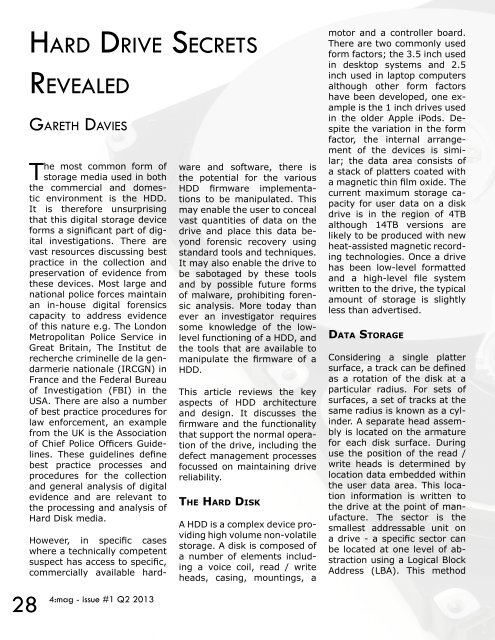Create successful ePaper yourself
Turn your PDF publications into a flip-book with our unique Google optimized e-Paper software.
28<br />
harD Drive secrets<br />
reveaLeD<br />
gareth Davies<br />
The most common form of<br />
storage media used in both<br />
the commercial and domestic<br />
environment is the HDD.<br />
It is therefore unsurprising<br />
that this digital storage device<br />
forms a significant part of digital<br />
investigations. There are<br />
vast resources discussing best<br />
practice in the collection and<br />
preservation of evidence from<br />
these devices. Most large and<br />
national police forces maintain<br />
an in-house digital forensics<br />
capacity to address evidence<br />
of this nature e.g. The London<br />
Metropolitan Police Service in<br />
Great Britain, The Institut de<br />
recherche criminelle de la gendarmerie<br />
nationale (IRCGN) in<br />
France and the Federal Bureau<br />
of Investigation (FBI) in the<br />
USA. There are also a number<br />
of best practice procedures for<br />
law enforcement, an example<br />
from the UK is the Association<br />
of Chief Police Officers Guidelines.<br />
These guidelines define<br />
best practice processes and<br />
procedures for the collection<br />
and general analysis of digital<br />
evidence and are relevant to<br />
the processing and analysis of<br />
Hard Disk media.<br />
However, in specific cases<br />
where a technically competent<br />
suspect has access to specific,<br />
commercially available hard-<br />
4:<strong>mag</strong> - issue <strong>#1</strong> <strong>Q2</strong> <strong>2013</strong><br />
ware and software, there is<br />
the potential for the various<br />
HDD firmware implementations<br />
to be manipulated. This<br />
may enable the user to conceal<br />
vast quantities of data on the<br />
drive and place this data beyond<br />
forensic recovery using<br />
standard tools and techniques.<br />
It may also enable the drive to<br />
be sabotaged by these tools<br />
and by possible future forms<br />
of malware, prohibiting forensic<br />
analysis. More today than<br />
ever an investigator requires<br />
some knowledge of the lowlevel<br />
functioning of a HDD, and<br />
the tools that are available to<br />
manipulate the firmware of a<br />
HDD.<br />
This article reviews the key<br />
aspects of HDD architecture<br />
and design. It discusses the<br />
firmware and the functionality<br />
that support the normal operation<br />
of the drive, including the<br />
defect management processes<br />
focussed on maintaining drive<br />
reliability.<br />
the hArd disk<br />
A HDD is a complex device providing<br />
high volume non-volatile<br />
storage. A disk is composed of<br />
a number of elements including<br />
a voice coil, read / write<br />
heads, casing, mountings, a<br />
motor and a controller board.<br />
There are two commonly used<br />
form factors; the 3.5 inch used<br />
in desktop systems and 2.5<br />
inch used in laptop computers<br />
although other form factors<br />
have been developed, one example<br />
is the 1 inch drives used<br />
in the older Apple iPods. Despite<br />
the variation in the form<br />
factor, the internal arrangement<br />
of the devices is similar;<br />
the data area consists of<br />
a stack of platters coated with<br />
a <strong>mag</strong>netic thin film oxide. The<br />
current maximum storage capacity<br />
for user data on a disk<br />
drive is in the region of 4TB<br />
although 14TB versions are<br />
likely to be produced with new<br />
heat-assisted <strong>mag</strong>netic recording<br />
technologies. Once a drive<br />
has been low-level formatted<br />
and a high-level file system<br />
written to the drive, the typical<br />
amount of storage is slightly<br />
less than advertised.<br />
dAtA storAge<br />
Considering a single platter<br />
surface, a track can be defined<br />
as a rotation of the disk at a<br />
particular radius. For sets of<br />
surfaces, a set of tracks at the<br />
same radius is known as a cylinder.<br />
A separate head assembly<br />
is located on the armature<br />
for each disk surface. During<br />
use the position of the read /<br />
write heads is determined by<br />
location data embedded within<br />
the user data area. This location<br />
information is written to<br />
the drive at the point of manufacture.<br />
The sector is the<br />
smallest addressable unit on<br />
a drive - a specific sector can<br />
be located at one level of abstraction<br />
using a Logical Block<br />
Address (LBA). This method




